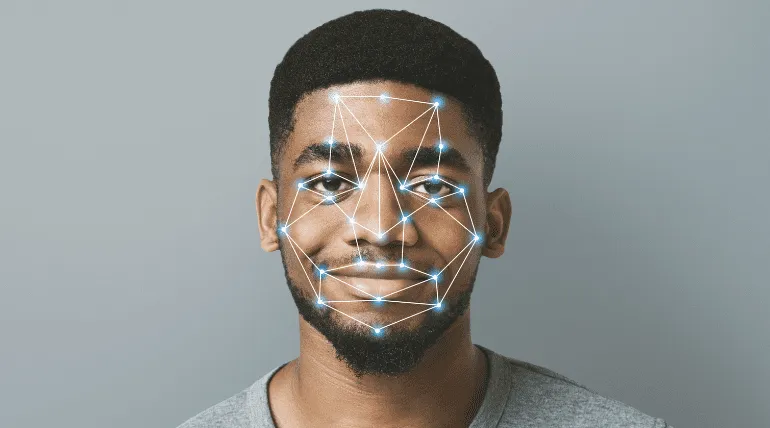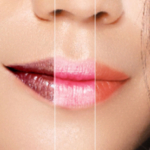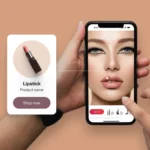Picture this: a virtual try-on that perfectly applies makeup to your face, adapting seamlessly as you smile or turn your head. That’s the magic of face tracking technology in the world of beauty AR.
And for brands in the beauty and color cosmetics industry, leveraging this cutting-edge tech is not just a trend—it’s a game-changer.
Dive into the intricacies of how face tracking works and discover why it’s essential in delivering realistic, responsive virtual makeup experiences that captivate and convert.
What is face tracking and how does it work?
Face tracking is a complex yet fascinating technology that merges several advanced fields These include computer vision, machine learning, artificial intelligence, and data science.
It’s designed to detect and follow the movements and features of a human face in real time, making it a cornerstone technology for a variety of applications. This includes everything from social media filters and gaming realism to practical tools like virtual try-ons in the beauty industry.
➥ The mechanics of face tracking
1. Detection
The first step in face tracking is face detection. This process involves identifying the human face within a digital image or video frame.
Using various algorithms, the system scans for typical facial structures (like the eyes, nose, and mouth) and isolates the face from the rest of the scene. Modern face detection methods are robust enough to identify faces across different conditions such as varying light, poses, and occlusions.
2. Landmark identification
Once a face is detected, the next step involves pinpointing specific facial landmarks. This is where the precision of face tracking truly shines, especially in applications like realistic makeup simulators.

Technologies like Visage Technologies’ FaceTrack can identify and track up to 151 distinct facial landmarks. These landmarks cover key areas of the face, including the mouth, eyes, nose, eyebrows, ears, and the overall facial contour. Identifying these points allows for detailed tracking of each facial feature, crucial for applications that rely on accurate face positioning, such as beauty AR.
3. Tracking
After landmarks are identified, the tracking process begins. This involves following the detected facial points as the face moves over time within the video or camera stream. Advanced tracking algorithms account for head rotations and translations, ensuring that the landmarks remain accurately positioned relative to the movement of the face.
This real-time tracking is essential for applications that require dynamic interaction, such as virtual try-ons where users can see how makeup looks as they move their faces.
Why is face tracking critical for realistic virtual makeup?
The realism in virtual makeup applications hinges significantly on the precision and responsiveness of face tracking technology.

By accurately mapping a user’s facial features and movements, the technology allows for a seamless application of virtual makeup, mirroring the effects of real cosmetic products.
This ensures that virtual makeup not only looks natural but also reacts in real-time to changes such as facial expressions and movements.
So, here’s why face tracking is indispensable for creating realistic virtual makeup experiences.
✧ Precision in application
The precision with which face tracking technology identifies and follows facial landmarks is crucial for realistic virtual makeup. Visage Technologies’ advanced face tracking system is capable of pinpointing as many as 151 facial landmarks.
This high level of detail, along with the refinement and alignment process, allows for an exact placement of makeup products on the face. For example, virtual lipstick is perfectly aligned with the lip’s contours, and eyeshadow can be blended accurately on the eyelids, respecting natural creases and folds.
This meticulous placement is essential for a realistic appearance, ensuring that the virtual makeup does not look out of place or artificial.

✧ Adaptive to real-time movements
Realism in virtual makeup is not just about static accuracy but also how makeup adjusts dynamically. As users move their heads, smile, talk, or change expressions, the virtual makeup needs to move seamlessly with their facial movements.
Face tracking ensures that virtual products remain correctly positioned relative to the underlying facial structure. For instance, as a person smiles, the blush on their cheeks should shift naturally, maintaining its intended effect without distortion or smudging, just as real makeup would.
✧ Enhanced user experience and engagement
The realistic rendering of makeup in real-time significantly enhances user engagement. Users can experiment with different looks and receive immediate feedback, making the virtual try-on process both fun and useful.
This level of interactivity is crucial for beauty brands aiming to provide a digital experience that closely mirrors a physical one. It helps customers make informed purchasing decisions by allowing them to see how products look on their actual faces under various expressions and lighting conditions.
✧ Consistency across diverse conditions
Our face tracking technology is designed to be robust, maintaining its accuracy and performance even in less-than-ideal conditions such as variable lighting, different skin tones, and various facial structures.
This consistency ensures that all users, regardless of their physical features or environment, can enjoy a realistic and satisfying virtual makeup experience. It helps in democratizing beauty tech, making it accessible and relevant to a wide audience. How is that?
Well, customers don’t have to go to the store to try makeup on and there’s no need to put it on your face and then go through the hassle of removing it. Plus, you can cut the cost of makeup samples.
✧ Boost in confidence and conversions
For beauty brands and retailers, realistic virtual try-ons powered by accurate face tracking can translate into higher consumer confidence in online product purchases, leading to increased sales conversions.

When customers can see a realistic representation of how makeup items will look on them, they are more likely to feel confident about their purchase decisions. This not only improves customer satisfaction but also reduces the likelihood of returns and exchanges due to unmet expectations.
Capitalize on precise AR face tracking with Arbelle
In conclusion, face tracking is fundamental in transforming virtual makeup applications from simple digital tools to advanced, highly interactive, and user-centered experiences.
It bridges the gap between digital exploration and real-world application, enhancing both the consumer’s journey and the brand’s ability to engage effectively with its audience.
This integration of technology fosters a new era of digital beauty solutions, where realism, personalization, and user satisfaction are paramount.
To find out more – or start your free trial – don’t hesitate to contact us today!
Get started with Arbelle
Contact us today and we’ll help you create the optimal beauty AR experience for your brand.

